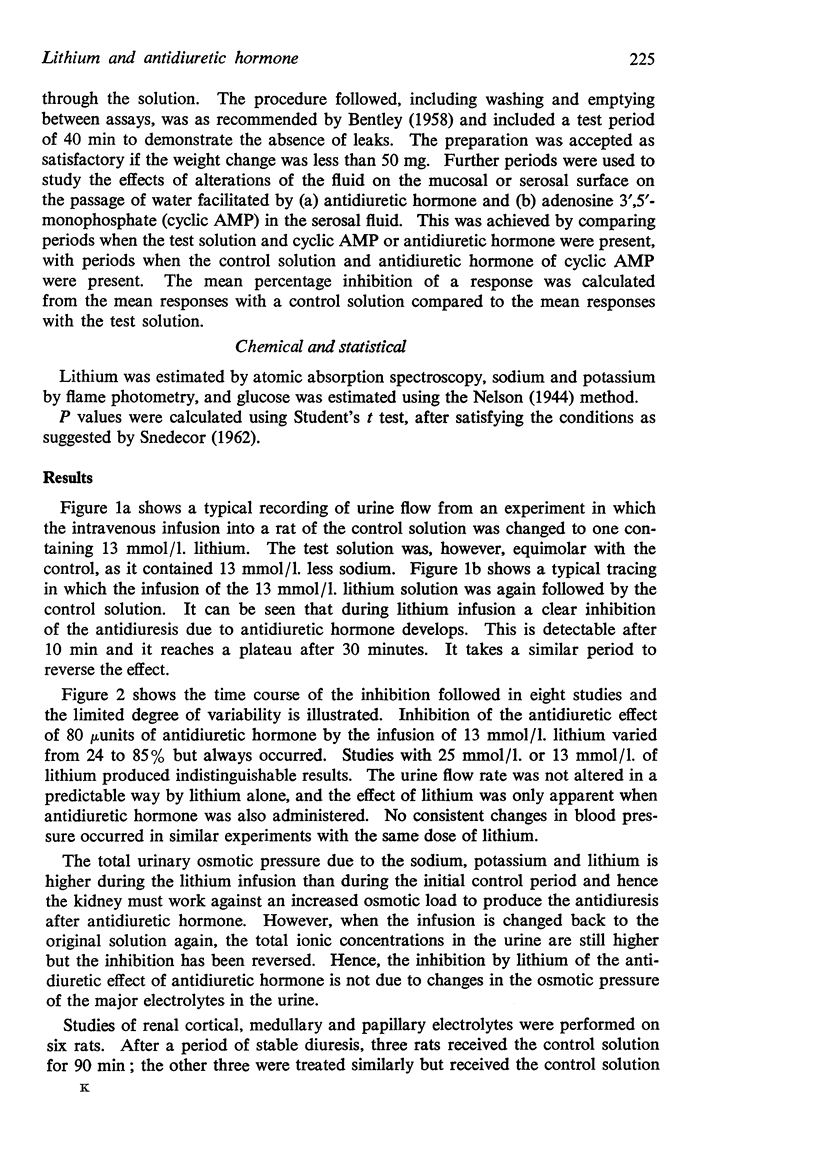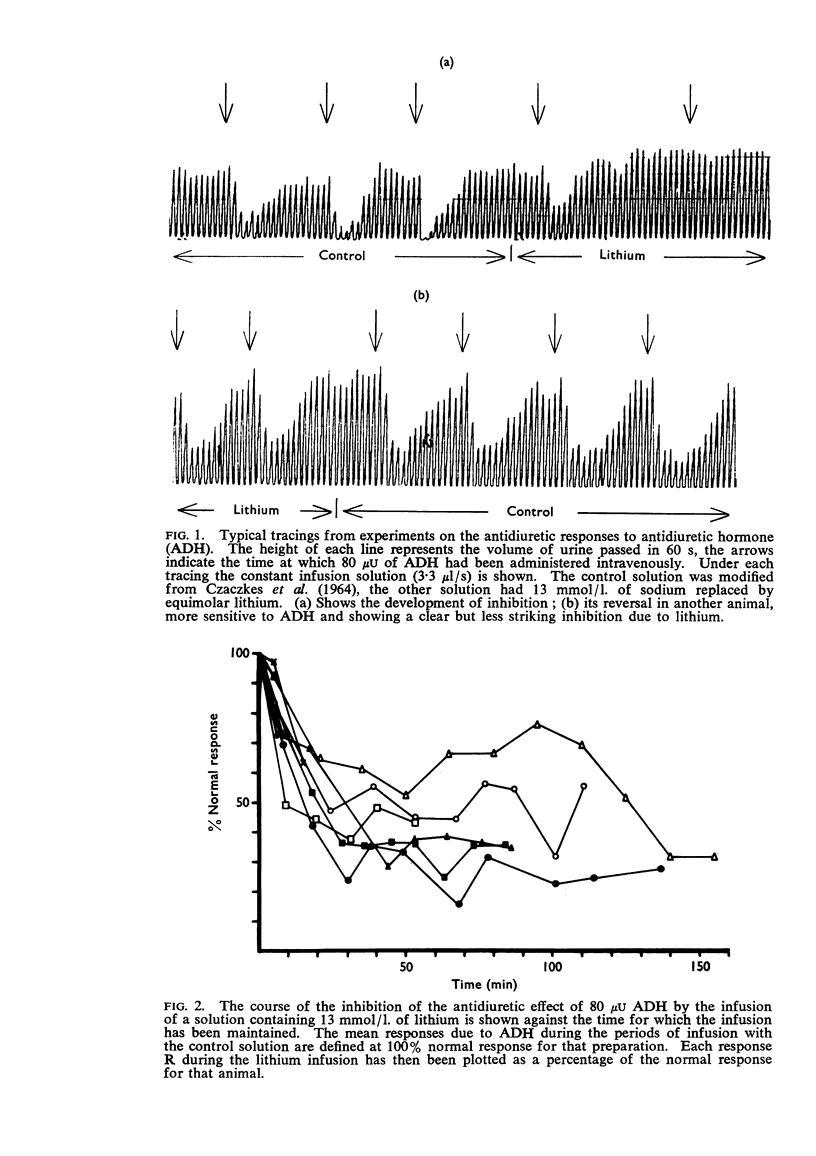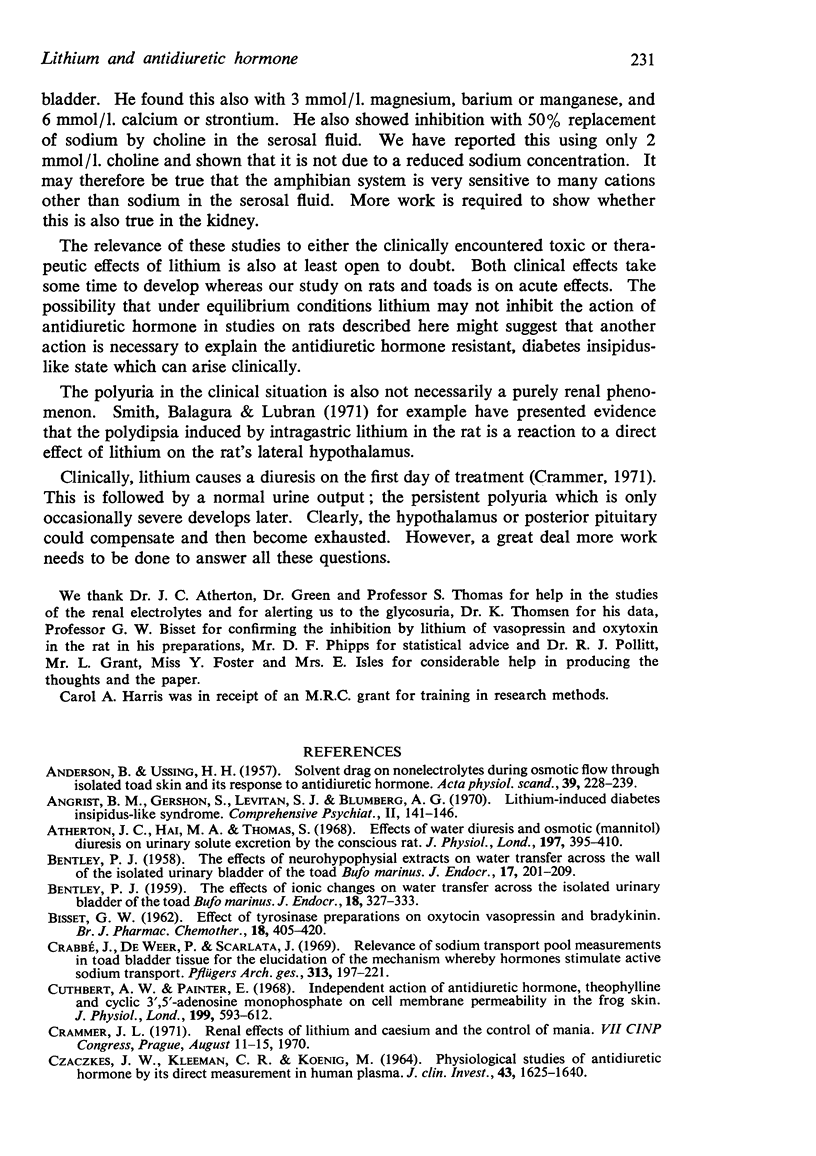Abstract
1. The effect of intravenous infusions of various ions on the antidiuretic action of antidiuretic hormone has been studied in rats.
2. Lithium (13 mmol/l.) reversibly inhibits the antidiuretic responses. Similar concentrations of potassium, rubidium, strontium, magnesium, choline and calcium do not. Lithium has a similar effect on the antidiuretic activity of oxytocin.
3. The inhibition is not simply related to blood nor whole body lithium concentrations.
4. Lithium (2 mmol/l.) in contact with the serosal surface also inhibits the transport of water facilitated by either 0·5 U/l. antidiuretic hormone or 1·1 mmol/l. cyclic adenosine monophosphate in the isolated toad bladder.
5. Choline (2 mmol/l.) on the serosal surface also inhibits the transport of water facilitated by vasopressin in the toad bladder.
Full text
PDF









Selected References
These references are in PubMed. This may not be the complete list of references from this article.
- ANDERSEN B., USSING H. H. Solvent drag on non-electrolytes during osmotic flow through isolated toad skin and its response to antidiuretic hormone. Acta Physiol Scand. 1957 Jun 8;39(2-3):228–239. doi: 10.1111/j.1748-1716.1957.tb01425.x. [DOI] [PubMed] [Google Scholar]
- Angrist B. M., Gershon S., Levitan S. J., Blumberg A. G. Lithium-induced diabetes insipidus-like syndrome. Compr Psychiatry. 1970 Mar;11(2):141–146. doi: 10.1016/0010-440x(70)90155-0. [DOI] [PubMed] [Google Scholar]
- Atherton J. C., Hai M. A., Thomas S. Effects of water diuresis and osmotic (mannitol) diuresis on urinary solute excretion by the conscious rat. J Physiol. 1968 Jul;197(2):395–410. doi: 10.1113/jphysiol.1968.sp008566. [DOI] [PMC free article] [PubMed] [Google Scholar]
- BENTLEY P. J. The effects of neurohypophysial extracts on the water transfer across the wall of the isolated urinary bladder of the toad Bufo marinus. J Endocrinol. 1958 Sep;17(3):201–209. doi: 10.1677/joe.0.0170201. [DOI] [PubMed] [Google Scholar]
- BISSET G. W. Effect of tyrosinase preparations on oxytocin, vasopressin and bradykinin. Br J Pharmacol Chemother. 1962 Apr;18:405–420. doi: 10.1111/j.1476-5381.1962.tb01420.x. [DOI] [PMC free article] [PubMed] [Google Scholar]
- CZACZKES J. W., KLEEMAN C. R., KOENIG M. PHYSIOLOGIC STUDIES OF ANTIDIURETIC HORMONE BY ITS DIRECT MEASUREMENT IN HUMAN PLASMA. J Clin Invest. 1964 Aug;43:1625–1640. doi: 10.1172/JCI105038. [DOI] [PMC free article] [PubMed] [Google Scholar]
- Crabbé J., De Weer P. Relevance of sodium transport pool measurements in toad bladder tissue for the elucidation of the mechanism whereby hormones stimulate active sodium transport. Pflugers Arch. 1969;313(3):197–221. doi: 10.1007/BF00586744. [DOI] [PubMed] [Google Scholar]
- Cuthbert A. W., Painter E. Independent action of antidiuretic hormone, theophylline and cyclic 3',5'-adenosine monophosphate on cell membrane permeability in frog skin. J Physiol. 1968 Dec;199(3):593–612. doi: 10.1113/jphysiol.1968.sp008670. [DOI] [PMC free article] [PubMed] [Google Scholar]
- DETTELBACH H. R. A method for assaying small amounts of antidiuretic substances with notes on some properties of vasopressin. Am J Physiol. 1958 Feb;192(2):379–386. doi: 10.1152/ajplegacy.1958.192.2.379. [DOI] [PubMed] [Google Scholar]
- Lingjaerde O. Uptake of serotonin in blood platelets: Dependence on sodium and chloride, and inhibition by choline. FEBS Lett. 1969 Apr;3(2):103–106. doi: 10.1016/0014-5793(69)80108-0. [DOI] [PubMed] [Google Scholar]
- Martin K. Concentrative accumulation of choline by human erythrocytes. J Gen Physiol. 1968 Apr;51(4):497–516. doi: 10.1085/jgp.51.4.497. [DOI] [PMC free article] [PubMed] [Google Scholar]
- Orloff J., Handler J. The role of adenosine 3',5'-phosphate in the action of antidiuretic hormone. Am J Med. 1967 May;42(5):757–768. doi: 10.1016/0002-9343(67)90093-9. [DOI] [PubMed] [Google Scholar]
- SCHOU M. Lithium studies. 1. Toxicity. Acta Pharmacol Toxicol (Copenh) 1958;15(1):70–84. doi: 10.1111/j.1600-0773.1958.tb00287.x. [DOI] [PubMed] [Google Scholar]
- Smith D. F., Balagura S., Lubran M. Antidotal thirst and lithium excretion in rats with hypothalamic lesions. Physiol Behav. 1971 Mar;6(3):209–213. doi: 10.1016/0031-9384(71)90027-8. [DOI] [PubMed] [Google Scholar]
- Sung C. P., Johnstone R. M. Evidence for the existence of separate transport mechanisms for choline and betaine in rat kidney. Biochim Biophys Acta. 1969 Apr;173(3):548–553. doi: 10.1016/0005-2736(69)90019-4. [DOI] [PubMed] [Google Scholar]
- Sutherland E. W., Robison G. A. The role of cyclic-3',5'-AMP in responses to catecholamines and other hormones. Pharmacol Rev. 1966 Mar;18(1):145–161. [PubMed] [Google Scholar]


